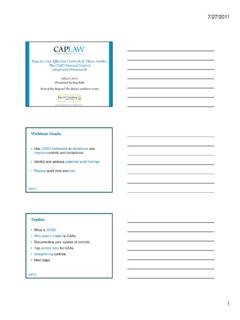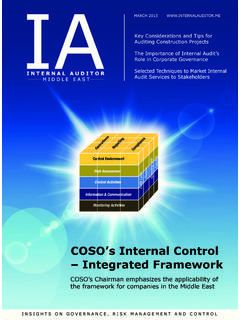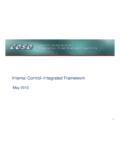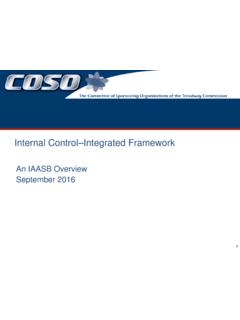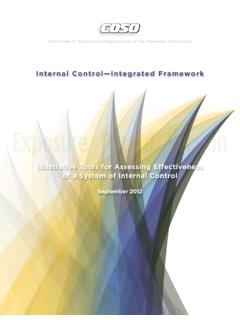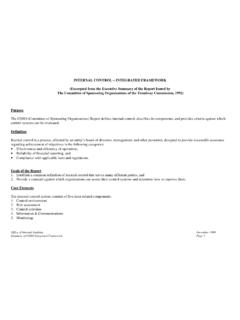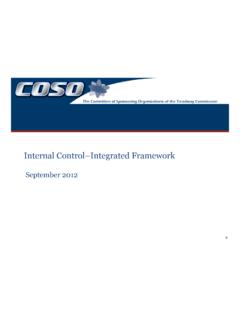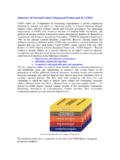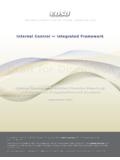Transcription of Volume 20, Issue 17 Heads Up - deloitte.wsj.com
1 COSO Enhances Its internal control integrated Frameworkby Jennifer Burns and Brent Simer, Deloitte LLPOn May 14, 2013, the Committee of Sponsoring Organizations of the Treadway Commission (COSO)1 released an updated version of its internal control integrated framework (the 2013 framework ). In addition, COSO released two illustrative documents; Illustrative Tools for Assessing Effectiveness of a System of internal control (the Illustrative Tools ) and internal control Over External Financial Reporting: A Compendium of Approaches and Examples (the ICEFR Compendium ) as well as an executive summary of the 2013 framework .
2 Originally issued in 1992, COSO s internal control integrated framework (the 1992 framework ) became one of the most widely accepted internal control frameworks in the world. COSO s primary objective in updating and enhancing the framework is to address the significant changes to business and operating environments that have taken place over the past 20 2013 framework and Illustrative Tools can be purchased from the AICPA Store. An executive summary of the 2013 framework is available for free on COSO s Web site.
3 This Heads Up provides an overview of the enhancements in the 2013 framework , a discussion of considerations for entities that use the 1992 framework in complying with Section 404 of the Sarbanes-Oxley Act of 2002 (SOX), and information about making the transition from the 1992 framework to the 2013 framework , including impacts on other COSO-related documents. In addition, the appendixes to this Heads Up compare the 2013 framework with the 1992 framework as well as highlight some of the expanded concepts in the 2013 framework .
4 For additional information about the frameworks, see Deloitte s February 6, 2012, and August 7, 2012, Heads Up in the 2013 FrameworkThe 2013 framework creates a more formal structure for designing and evaluating the effectiveness of internal control by: 1. Using principles to describe the components of internal control The 2013 framework contains 17 principles that explain the concepts associated with the five components of the COSO framework ( control environment, risk assessment, control activities, information and communication, and monitoring activities).
5 In developing the 17 principles, COSO focused on concepts from the 1992 framework ; considered the principles that were developed and articulated in COSO s 2006 internal control Over Financial Reporting Guidance for Smaller Heads UpJune 10, 2013 Volume 20, Issue 17In This Issue : Enhancements in the 2013 framework Effective Systems of internal control COSO Transition Guidance and Impact on Other COSO Documents internal control Over External Financial Reporting Illustrative Tools Appendix A Comparison of Principles in the 2013 framework With Related Sections in the 1992 framework .
6 And Summary of Enhanced Concepts in the 2013 framework Appendix B Summary of Concepts and Discussion in the 2013 framework Related to the Use of Outsourced Service Providers Appendix C Summary of Concepts and Discussion in the 2013 framework Related to Information Technology1 COSO is a joint initiative of five private-sector organizations and is dedicated to providing thought leadership by developing frameworks and guidance on enterprise risk management, internal control , and fraud deterrence.
7 The five private-sector organizations are the American Accounting Association, the American Institute of Certified Public Accountants, Financial Executives International, the Institute of Management Accountants, and the Institute of internal Companies ( Small Business Guidance ); and considered the significant changes in business, operating environments, and governance since 1992. COSO intends the principles to help companies design effective systems of internal control and evaluate whether those systems are functioning effectively.
8 The 2013 framework presumes that because the 17 principles are fundamental concepts of the five components, all 17 are relevant to all entities. Consequently, if a principle is not present and functioning, the associated component is not present and functioning. In rare circumstances, because of industry, regulatory, or operating matters, management may determine that a principle is not relevant to a component. To further describe the principles, the 2013 framework uses points of focus, which typically are important characteristics of the principles.
9 While the points of focus may help management design, implement, and evaluate internal control and assess whether relevant principles are present and functioning, they are not required for assessing the effectiveness of internal control . Management may determine that some of the points of focus are not suitable or relevant and may identify and consider others. 2. Creating a more formal way of designing and evaluating internal control in accordance with the principles. See discussion below under Effective Systems of internal control .
10 While fundamental concepts in the 2013 framework are similar to those in the 1992 framework , the 2013 framework adds or expands discussions about each component and principle, including enhancements such as the detailed points of focus. For example, although the concept of identifying and responding to risks was present in the 1992 framework , the 2013 framework includes more detailed discussions about risk assessment concepts, including those related to inherent risk, risk tolerance, how risks may be managed, and linkage between risk assessment and control addition, unlike the 1992 framework .
